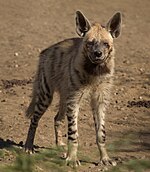Indus Valley Desert
Location and description
The Indus Valley desert covers an area of 19,501 square kilometers (7,529 sq mi) in northwestern Punjab Province between the Chenab and Indus rivers. The Indus Valley Desert is drier and less hospitable than the northwestern thorn scrub forests that surround it with temperatures ranging from freezing in winter to extremely hot (more than 45 °C (113 °F)) in summer with only 400–600 mm (20–20 in) of rainfall per year.
Biodiversity

Flora
The desert vegetation is quite varied due to the variety of temperatures with Khejri shrubs being the characteristic species.



Fauna
The desert is home to five large mammals: Indian wolf, striped hyena, caracal, Indian leopard and the urial (Ovis orientalis punjabensis) along with many rodents and other mammals. Meanwhile, the 190 species of bird in the desert include the red-necked falcon.
Threats and preservation
Like the nearby Thar Desert, the Indus Valley desert has little farming or grazing due to its hard climate and therefore the natural habitats are almost intact. A 2017 study estimated approximately 12,176 square kilometers in protected areas.
However, hunting still goes on and is a threat to caracals, wolves and other mammals.
References
- ^ "Indus Valley Desert". Terrestrial Ecoregions. World Wildlife Fund.
- ^ Dinerstein, Eric [in German]; Olson, David; Joshi, Anup; et al. (2017-04-05). "An Ecoregion-Based Approach to Protecting Half the Terrestrial Realm". BioScience. 67 (6): 534–545, Supplemental material 2 table S1b. doi:10.1093/biosci/bix014. ISSN 0006-3568. PMC 5451287. PMID 28608869.